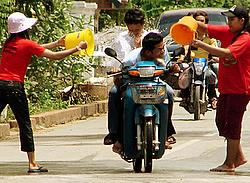Laos New Year
Luang Prabang, Laos
 In mid-April the Laos New Year starts with a splash in the World Heritage city of Luang Prabang. A huge water fight marks the beginning of Songkran, which takes its name from the Sanskrit word samkranta meaning fully passed over. Ancient stargazers marked the passing of Pisces into Aries in the Zodiac with this water-crazed celebration and modern festivities continue the tradition, but now include motorized vehicles in the water throwing mayhem. Luang Prabang takes its celebration seriously, stretching the event out to a full seven days with many people dressing in traditional clothes and everyone getting very wet.
In mid-April the Laos New Year starts with a splash in the World Heritage city of Luang Prabang. A huge water fight marks the beginning of Songkran, which takes its name from the Sanskrit word samkranta meaning fully passed over. Ancient stargazers marked the passing of Pisces into Aries in the Zodiac with this water-crazed celebration and modern festivities continue the tradition, but now include motorized vehicles in the water throwing mayhem. Luang Prabang takes its celebration seriously, stretching the event out to a full seven days with many people dressing in traditional clothes and everyone getting very wet.
Songkran is more than just water. Spiritually it is the passing of the old and the receiving of the new. Every household honors the transition of the spirits by giving their house a thorough cleaning when the old spirit departs. The seven days of Songkran start with this spiritual departure and each day after is marked by its own ceremony. Along with the cleaning on the first day, locals gather at Hat Muang Khoun, an island beach, to erect and adorn miniature sand stupas. The second day is the highlight for tourists as a colorful, costumed parade down Luang Prabang's main avenue takes place. After two days of water enthusiasm, anyone would need a day of rest and the third day is just this as everyone stops splashing each other and takes time to wash the Buddha at their local wat.
The dawn of day four is a town pilgrimage to the summit stupa of Phu Si to make offerings of sticky rice. The afternoon is reserved for sacred string-tying ceremonies when family and friends are bound to each other symbolically with the tying of a white string around the wrist. On day five the Pha Bang (a Khmer-style standing Buddha figure kept at the Royal Palace Museum) leaves the Royal Palace Museum and is taken in a procession to Wat Mai. On day six the new spirit arrives. The arrival of this new spirit is central in the Songkran week and the Buddhist holy images are bathed by pouring water onto them through wooden channels shaped like nagas (mythical water serpents). Elder monks and family members receive the same cleansing. Young Laos pour water over the hands, palms pressed together, of their relatives out of respect. The last day of the festival the Pha Bang is returned to the museum and everyone begins the process of drying out after a wet week.
 The procession of the Pha Bang to Wat Mai on day five has three bizarre figures that are a portrayal of the Lao Thoeng, Luang Prabang's original residents. The figures wear large, red, wooden heads with a thick hair draped over their bodies. Two of the wooden heads are circular and have big teeth and thick eyebrows. The lowland Lao imagine these to be Lao Thoeng spirits and they are the guardians of the environment and they are deeply respected. The third figure wears a lion's head and is thought to be a representation of a Khamu king. The three figures receive offerings along their processional route and dance at each stop.
The procession of the Pha Bang to Wat Mai on day five has three bizarre figures that are a portrayal of the Lao Thoeng, Luang Prabang's original residents. The figures wear large, red, wooden heads with a thick hair draped over their bodies. Two of the wooden heads are circular and have big teeth and thick eyebrows. The lowland Lao imagine these to be Lao Thoeng spirits and they are the guardians of the environment and they are deeply respected. The third figure wears a lion's head and is thought to be a representation of a Khamu king. The three figures receive offerings along their processional route and dance at each stop.
The spiritual aspects of the festival are held in these traditional ceremonies, but the fun is in the flying buckets of water. April is the hottest time of the year in Southeast Asia and this festival gives everyone a chance to cool off. Indeed, the temperature drops noticeably with the presence of so much water in the air. Everyone takes part and it is impossible to go out into the street without getting doused, as even the tiniest child will chase you down (and don't think for a second that they don't have excellent aim.) Seven days of soaking can get a bit tedious, but the locals are tireless water-tossers and will always soak you with a smile. Happy New Year!
